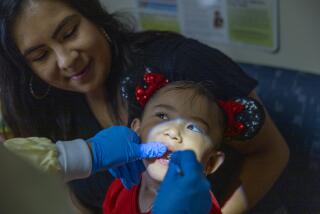Talk Shows, Movies, Music . . . at the <i> Dentist?</i>
- Share via
Dentophobics, as they’re known in the trade, have fewer excuses for bad teeth these days.
Dentists are striving to make their milieu more tolerable for the estimated 35 million Americans who become anxious just thinking about a routine visit.
Technology is one part of the stress-reduction scenario. In some dental offices, it’s now possible to watch your favorite talk show or movie as you’re drilled and filled. There’s a new anesthetic-filled dental patch under study, meant to make the injection less painful.
Improved interpersonal skills are playing a role. Dentists are becoming more sensitive, inquiring about fears and trying to ease them.
Channel Surfing: Before Sharron Walker settled in recently for a one-hour gum surgery, her dentist’s assistant asked if she’d like to watch television. That sounded like a fine idea to the 47-year-old Santa Monica administrative assistant, who says she’s “really sensitive to pain” in her mouth.
She was handed what looked like a pair of oversized ski goggles with stereo earphones--and was soon immersed in a talk show, all but forgetting about the oral activity.
Walker was wearing Virtual Vision Rx, introduced to dentists late last year. The system is connected to VCRs or video games. It has a built-in display monitor that projects the video image onto a lens inside the goggle and in front of the right eye, says Melissa Pearson, a spokeswoman for Virtual Vision, the Redmond, Wash.-based maker.
“The patient can adjust the focus,” she says, “so that the image appears to float out in front of you.” Patients can view movies, watch television or play video games. The dentist has access to a mute button in case he or she needs to talk with the patient.
The Trend: About 10 dentists in the Los Angeles area and more than 1,000 nationwide now use the $800 system, says Pearson, who expects to target the podiatrist market next. The firm began marketing the system to dentists when some requested it after seeing the consumer version marketed by telephone.
The Reviews: “It seems to be an exceptional stress reducer,” says Dr. Victor Pineschi, the Brentwood periodontist who performed Walker’s surgery and is one of the first dentists to offer the system.
The system is especially useful when patients undergo lengthy procedures such as multiple fillings or crown work, adds Dr. Christine Dumas, a Marina del Rey dentist. She invites her patients to choose from her video collection, which includes “The Sound of Music” and “Top Gun.”
“The hardest thing is not to sing along,” Dumas says. Like many other dentists, Dumas and Pineschi say they also have no objection to patients listening to Walkmans during lengthy procedures. Some dentists even supply the headsets.
Low-Tech Talk: All the high-tech gadgets won’t help, Dumas emphasizes, if the dentist and patient don’t communicate. “All these advances are helpful adjuncts,” says Dumas, who is also a consumer adviser for the American Dental Assn. and a USC assistant professor of clinical dentistry.
An enlightened dentist, she says, will always ask a new patient, “Have you had any bad experiences in a dental office?”
“The dentist needs to find out what happened and when,” Dumas says. Was the experience firsthand? Or did it happen to a friend?
Dental anxiety is often traceable to a traumatic dental experience in early childhood, some research suggests, while a lower-than-usual pain threshold is at the root of other discomfort.
Numbed to the Max: For years, dentists have used an anesthetic spray or gel to numb the area where the local anesthetic will be injected. Now, there’s a patch under study that developers hope will numb the area even better.
Developed by Noven Pharmaceuticals Inc. of Miami, the patch is about an inch long and three-quarters of an inch wide, says Mitchell Goldberg, Noven’s executive vice president. “It looks like a thick piece of Scotch tape,” says Dr. Milton Houpt, chairman of the department of pediatric dentistry at the University of Medicine and Dentistry of New Jersey, Newark, and one of the investigators.
The patch is filled with lidocaine, a common dental anesthetic. It’s left in place for a few minutes and then removed before the injection. The patch might numb the area more effectively than gels or sprays, researchers speculate, because it keeps the medicine concentrated at the site.
Noven plans to ask for Food and Drug Administration approval to market the patch soon.
More to Read
Inside the business of entertainment
The Wide Shot brings you news, analysis and insights on everything from streaming wars to production — and what it all means for the future.
You may occasionally receive promotional content from the Los Angeles Times.










